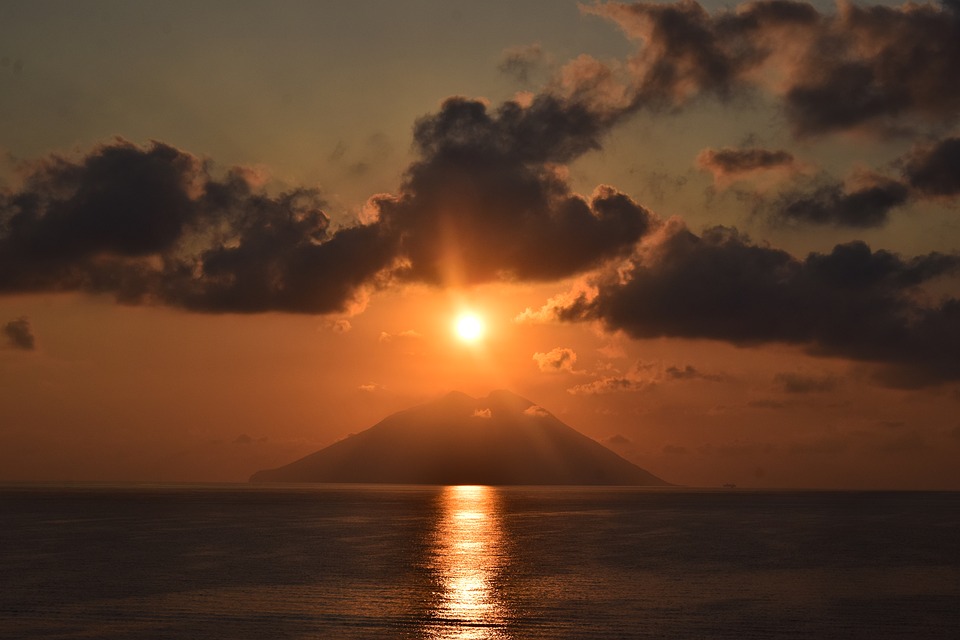Stromboli: the black giant exploding
GRAND TOUR BLOG | 22 April 2020

Stromboli: the black giant exploding

It is a black giant, “he“, It stands in all its grandeur on the intense blue sea. For thousands of years the volcanic cone with the plume and its “shots”, as they are called rumble of explosions, It is like a beacon for sailors.

To those who come to the island, As soon as the east begins to darken, It becomes the flame of the volcano visible, at regular intervals 15/20 minutes. It inspires an awe of this young volcano 100.000 years, perhaps unique in the world for its three mouths constantly explosive activity; among the highest in Europe, 2400 meters between cone and bottom: “A volcano 5 stars”. The inhabitants live together, at least three thousand years, with rumblings and frequent eruptions.
The island, at first, It was an agricultural colony of Lipari and inhabited only during the sowing and harvesting. subsequently, around the sixteenth century BC, It was formed a first human settlement in the San Vincenzo, behind the church. The development of the island is historically linked to the sea and maritime tradition. Stromboli was a must for those crossing the Tyrrhenian.
The place

The island is located in the southern Tyrrhenian, in exterior eastern span of the archipelago, between the’Panarea and the Calabrian coast, which it is 55nbsp;km (Capo Vaticano). Its inhabitants are distributed in the coastal towns of San Bartalo, St. Vincent and Piscità, on the north-east coast, in the small village of Ginostra, 50 residential, place to the southwest, accessible only by sea and in other smaller settlements.
From the morphological point of view the island and constituted by a single volcanic cone (volcano layer) that descends below sea level to just over 2000 meters. The long activity has conferred an irregular quadrilateral shape and, with northeast-southwest orientation, naturally evolving. The coastline is mostly high, rocky and stratified, due to the overlap of volcanic materials emitted during the various stages of activity are much reduced, instead, beaches and low-lying areas (stairs, San Vincenzo, Punta Lena, Ginostra).
The highest point and Cresta Vancori (924 m s.l.m.), divided by the second island ridge, Pizzo Sopra la Fossa (918 m), by a narrow passage (Portella della Croci). Both are what remains of the summit rim of an ancient volcano. Volcanic activity is active today in volcano Sciara (or recent Stromboli), place to Pizzo northwestern Fossa, a quota 725 m s.l.m., inside the building previous volcanic. This volcano had to 2002 three constantly active vents inside three craters (Northeast Crater, central Crater, Crater southwest) which together constitute what is commonly called the terrace.

The climb to the craters
The climb to the summit craters of the volcano Stromboli, It is effected via a steep path that leads out leads first to Punta Labronzo and then rises rapidly up to 918 m height of the Pizzo sopra la Fossa. It is a pleasant walk, crowned by the exceptional performance, Product of the frequent volcanic explosions, which gives the opportunity to follow in spirit the geological history of the island from its former base, said Paleostromboli, the current volcano.
Stromboli is a mountain and has areas with considerable difficulties in accessing, especially if they are walked at night; the difficult terrain and the perennial eruptive activity recommend go for the trip to experienced guides who are familiar with the volcano and are up to date on the conditions of the eruptive activity. They can help the ascension tourist Stromboli, showing the natural beauty that crosses, and thus making sure the vision of the show's most coveted, the "fireworks".
Curiosity
In 1949 the director Roberto Rossellini turns “Stromboli”, starring Ingrid Bergman. In Via Vittorio Emanuele there is a plaque indicating the house where, the director and the actress, They lived their romance.
In 2000 l’UNESCO He has declared the archipelago a World Heritage.



